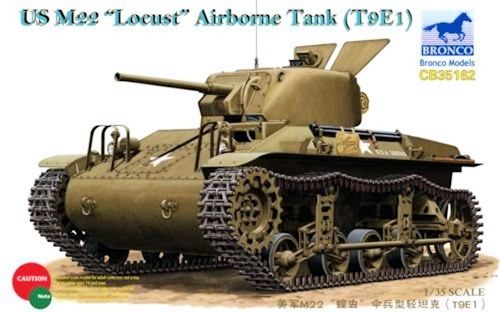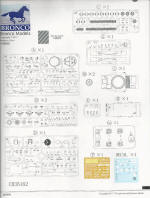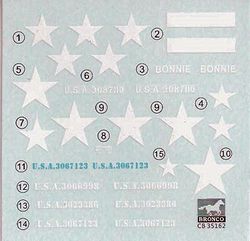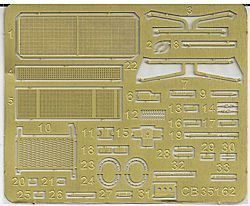
Bronco 1/35 M-22 'Locust'
| KIT #: | CB 35162 |
| PRICE: | $53.00 SRP |
| DECALS: | Five options |
| REVIEWER: | Robert Myers |
| NOTES: | New tool kit |

| HISTORY |
The M22 "Locust" light tank (T9E1), designed by the U.S. primarily for airborne
operations, was one of the smallest tanks used by the Allies during WWII. It had
a crew of three and weighed 6.7 metric tons (7.4 short tons). The armament
consisted of a 37-millimeter main gun and a coaxial .30-06 Browning machine-gun
mounted in a turret.
The British Ordinance Department formulated a design concept requiring the
development of a light tank that would aid airborne units during critical
missions to be delivered by airborne means. The light tank would support the
airborne infantry until reinforcements from the main force arrived. In May of
1941 design began on the M22 Locust light tank at the Marmon-Herrington Company.
Production began in April 1943 and ended in February 1944 with a total
production of 830 tanks. Under lend-lease, 260 Locusts were given to the
British.
The M22 was constructed of welded steel plate. The front armor was 1 inch thick
with the sides being approximately ½ inch plate. The sloped front and sides
added additional protection by deflecting projectiles upward.
The vehicle was powered by a Lycoming O-435-T six cylinder, air-cooled, opposed
cylinder, aircraft engine yielding 162 hp. This engine provided driving range of
110 miles with a full tank of 57 gallons of gasoline with a top speed of 35 MPH
(assumedly road driving). The drive sprockets were powered directly by the 4
speed transmission/differential at the front of the vehicle and engaged the
steel track through sprocket wheels on each side. Four road wheels connected to
a volute spring suspension provided support for the vehicle. The rear idler
wheel was used to control track tension.
The vehicle dimensions are: length 12ft. 11in., width 7ft. 3.75in. and height
5ft. 8in. This resulted in an extremely tight crew compartment The low
silhouette was somewhat unusual for American light tanks of the era, a decided
advantage by offering a low profile and allowed for loading into a British
Hamilcar glider. The M-22 could also be carried under the belly of a C54 cargo
plane, after turret removal, via 4 heavy lifting lugs on the side of the hull
In March 1945, the 6th Airborne Division was informed that it would be
participating in Operation Varsity, an airborne operation in support of 21st
Army Group crossing the River Rhine during Operation Plunder. Eight Locusts from
the regiment, divided into two troops of four, would land with the 6th
Airlanding Brigade in landing-zone P. The rest of the regiment would arrive by
road after crossing the Rhine with 21st Army Group.
The eight Locusts were loaded into separate Hamilcar gliders and on the morning
of 24 March were towed from the airfield by Handley Page Halifax heavy bombers
to join the rest of the gliders and transport aircraft carrying the two airborne
divisions. Weather conditions for the operation were excellent, with clear
visibility, and all eight gliders arrived in the vicinity of the landing zone
without incident. During their attempts to land, however, the small force was
severely depleted; one glider broke away from the Halifax towing it and
disintegrated. Three more gliders crashed as they landed.
Six Locusts landed intact on the landing zone, including several with
significant damage, but two of these tanks never reached the rendezvous point
for the regiment. One undamaged tank came to the aid of a group of American
paratroopers who were under fire from a German self-propelled gun, but was
rapidly knocked out by the German vehicle, wounding two crew members. A second
tank broke down as it attempted to tow a jeep out of a crashed glider. Of the
four Locusts that reached the rendezvous point, only two were undamaged and
fully fit for action; these two were immediately deployed to the high ground
east of the Diersfordter Wald, while being covered by the two damaged tanks.
Upon arrival they were engaged by German troops and had to be supported by an
infantry company, and soon their presence began attracting a great deal of
artillery and anti-tank fire. Although neither of the tanks were hit, a number
of infantrymen were killed or wounded and after several hours the tanks were
forced to withdraw.
After the end of WWII the British Army disposed of a small number of Locusts by
transferring them to foreign militaries. A few Locusts even found their way to
U.S. farms, where they had their turrets removed and served as tractors.
| THE KIT |
 This
kit is small! The molding appears to be excellent for all of the parts including
the very fragile looking grab handles. The 23 step instructions, with color
illustrations, are the best I have seen (this is my first Bronco kit). Each step
shows the different options you can build. The building sequence is clear and
proceeds in a logical manor. You may want to modify the sequence to fit your
painting style. There are options for five U.S. tanks. The only real noticeable
differences are the placement of the stars. There is a very nice 8x12½ inch
color print of the M-22 included in the box. I think it is nice enough to fram
This
kit is small! The molding appears to be excellent for all of the parts including
the very fragile looking grab handles. The 23 step instructions, with color
illustrations, are the best I have seen (this is my first Bronco kit). Each step
shows the different options you can build. The building sequence is clear and
proceeds in a logical manor. You may want to modify the sequence to fit your
painting style. There are options for five U.S. tanks. The only real noticeable
differences are the placement of the stars. There is a very nice 8x12½ inch
color print of the M-22 included in the box. I think it is nice enough to fram e.
e.
All of the hatches can be posed open or closed. There is minimal detail for the
turret interior and none for the driver. I am impressed that Bronco include d
some tarps and packs to put on the outside of the tank.
d
some tarps and packs to put on the outside of the tank.
I fear plastic track links and photo-etch. This track just has a few individual
pieces to make the curve around the sprocket to connect the upper and lower one
piece runs of track. The upper track even has the sag molded in! As for the
photo-etch. It looks do-able. It is mostly engine screens, muffler guard and
light guards. They are pretty good size and look easy to manage.
| CONCLUSIONS |
This is a small kit with lots of small pieces. With patience it looks to be a
fun build that will give you some experience with photo-etch, without being
overwhelming for the average builder. However, do to the small parts and
photo-etch it is not for a beginner.
April 2014
Thanks to my tax refund for buying this one.
If you would like your product reviewed fairly and fairly quickly, please contact the editor or see other details in the Note to Contributors.